AI at Work
50+ AI Image Prompts That Actually Work for Marketing Campaigns

Akshita Sharma · Content Marketing Associate
November 6th, 2025 · 29 min read

More than 50% of marketers use AI to create images. However, while AI image generators are incredibly powerful, many teams still get stuck in trial-and-error cycles trying to write prompts that create visuals consistent with their brand.
That's exactly why we put hundreds of prompt variations to the test across real marketing campaigns. What we discovered was this:
The right structure, the right descriptors, and the right technical parameters in your AI image prompts can generate compelling visuals that align with your brand identity.
We've distilled these learnings into actionable AI image prompt templates, with clear guidance on how to adapt each one for your brand and campaign goals.
Each template (blog, social media, website graphics, etc.) includes the core prompt structure, style variations, and examples of how successful marketing teams are using them today.
Try the prompts to fast-track your experimentation and create professional marketing visuals in minutes.
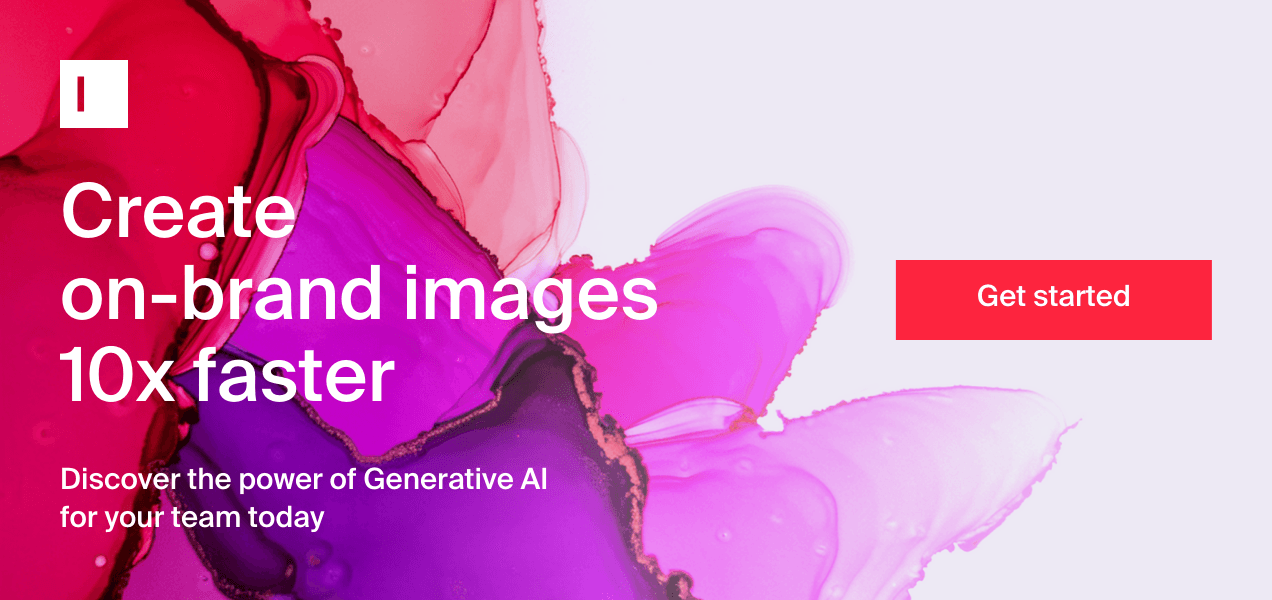
At a glance: What makes a good AI image prompt?
A good AI image prompt has four elements:
[image type] + [subject] + [background setting] + [style]
For example: "A product photo of running shoes on white marble in a minimalist studio, shot with natural lighting and shallow depth of field."
This formula works because AI prioritizes the first few words, so you lead with the image type and subject, then build on that with supporting details.
What are AI image prompts?
An AI image prompt is a brief set of guidelines that tells the AI exactly the kind of visual you want to create.
At its core, a prompt bridges the gap between what's in your mind and what appears on the screen. You might describe a mood, specify details, or set a scene. The AI takes your description and transforms it into a visual composition. The more specific and intentional your prompt, the closer the result matches your vision.
💡 New to AI prompting? Check out our prompt library to find proven AI prompts for using Typeface's specialized agents for various marketing tasks, including image generation.
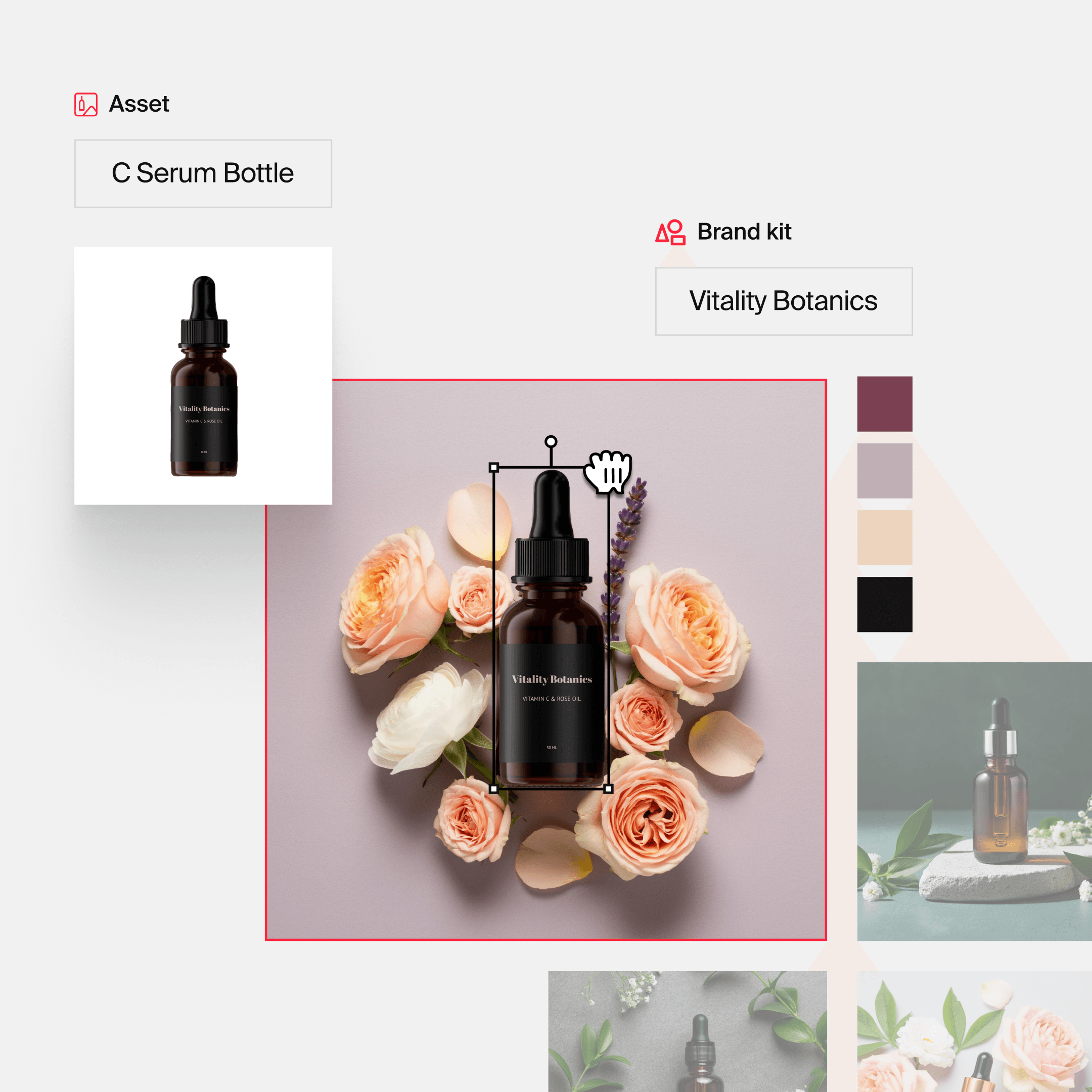
How it works in Typeface
You create images by describing what you want, in everyday language. Rather than relying on designers for visuals every time, you direct an AI agent to create them. If the images must be refined by designers or shared as inspiration for a campaign, your teams can collaborate on one canvas.
You don't need to be a prompt engineering expert — Typeface enhances simple prompts, layering them with details to create polished, aesthetically pleasing images. However, if you've a specific vision in mind, learning how to craft effective AI image prompts can help you achieve precise results on the first try.
How to write good AI image prompts
AI responds to prompts — image prompts are the raw material. But great images come from more than words alone. They're shaped by your visual strategy and the choices you make as you refine and edit.
Use a creative brief as a starting point
Describe the visuals in clear, everyday language, but make sure to include the essential details that define your idea.
Review the visual. If needed, refine your prompt through a few iterations to get the perfect result.
Use built-in AI editing for simple edits and tool integrations for advanced editing.
Have a strong visual content strategy
With a good AI image generator, anyone can create polished images. The way you stand out comes from something else: audience insights, expertise, and a genuine desire to connect.
The strategies you’ve in place to create strong visual content also apply to AI generations:
Alignment of visual content with brand mission, target audience, and campaign goal.
Use of consistent branding elements like logos, color palettes, typography, and styles.
Graphic design fundamentals for visually appealing and accessible images.
Platform optimization for the best display and engagement.
Visual storytelling honed through deep audience understanding and professional experience.
Experimentation with trends, when suitable, to stand out.
Four essential elements of every AI image prompt
Element 1: Image type (product shot, illustration, photo)
Element 2: Subject/Main focus (product, person, object, place)
Element 3: Background setting (environment and context)
Element 4: Style (artistic approach, lighting, mood)
AI image prompt formula:
A [image type] of [subject] in [background setting], [composition style].
How to bring these elements together
Be specific. Don’t just say “a dog”— say “a golden retriever.” Instead of “a child skating,” try “a professional photo of a young girl skating.”
The more specific your prompt, the faster and more accurately the AI can generate an image that matches what you’ve in mind.Layer in the details that matter. AI image generators can work with multiple elements to create visuals that have depth and complexity. So, add details, context, and aesthetics for richer, more realistic outputs.
Also, AI often prioritizes the first few words in your prompt. That means you should lead with the image type and subject, then build out the supporting details like background, lighting, or mood.
Example:
A product shot of wireless earbuds on a matte black surface, captured in soft directional lighting with a clean, modern aesthetic.
Why it works:
Leading with “product shot” and “wireless earbuds” helps the AI focus on the right subject and visual tone.
More examples of better image prompts using specifics plus layers
Basic prompt:
A golden retriever
Layers to add:
Add subject action (what the subject is doing): snoozing on a couch, running through a field, playing fetch with a ball
Add context (what’s happening around the subject): sunlight streaming through a window, autumn leaves falling in the background, a cozy living room with soft lighting
Add style/aesthetic (medium, framing, camera details): high-resolution lifestyle photo, soft-focus natural lighting, wide-angle shot, warm color palette, digital painting style
Full prompt:
A high-resolution lifestyle photo of a golden retriever snoozing on a couch in a cozy living room with afternoon sunlight streaming through the window.
Using the above, you’re much more likely to generate an image that reflects your original intent.
Basic prompt:
A young girl skating
Layers to add:
Add subject action: gliding gracefully on the ice, mid-jump performing a spin, tying her skates before practice
Add context: in an indoor skating rink with spectators, on an outdoor frozen lake surrounded by snow-covered trees, under bright spotlights during a performance
Add style/aesthetic: professional sports photograph, cinematic framing, motion blur effect, soft winter lighting, vibrant color tones
Full prompt:
A professional photo of a young girl skating on a frozen lake, with snow-covered trees in the background and soft winter lighting.
Here again, the specifics plus the layers of detail guide the AI to a much closer output than would have otherwise been possible.
Iterate and refine
Your first prompt is rarely your best prompt.
As Typeface’s Founding Member Frank Chen puts it:
With any AI tools, the key is to iteratively get to the result you want. Modify the prompt, generate it multiple times, and iterate until you get a set of images that you can then filter down to the ones you like.
This approach helps you build a library of variations to choose from, rather than settling for the first result.
For more information, check out a great piece from our image experts on how to write good AI image prompts.
Generic vs optimized AI image prompts for marketing use cases
Generic prompt | Optimized prompt | Why it works better |
Coffee cup | A product photo of a ceramic coffee mug on reclaimed wood in a cozy café setting, warm morning light, shallow depth of field | Includes all four elements (image type, subject, setting, style) and provides clear visual direction |
Mother’s Day social media post | An artistic illustration for Instagram featuring diverse mothers and daughters surrounded by blooming flowers, warm pastel tones, hand-drawn flat design style, space for “Happy Mother’s Day” text | Platform-specific with defined subjects, setting, and style |
Skincare product | A product shot of a glass skincare serum bottle on beige linen fabric, surrounded by eucalyptus leaves, captured with soft diffused light | Adds texture, color, and tone for a polished, editorial-quality image |
Fitness ad | A high-energy photo of a young woman running on a city bridge at sunrise, athletic wear brand logo visible, motion blur for dynamism | Connects subject, setting, and style to the marketing use case |
Running shoes | A product photo of red running shoes on white marble in a minimalist studio, shot with natural lighting and shallow depth of field | Front-loads image type and subject, then builds supporting details |
AI image editing
AI image generators may have built-in editing features to correct the small flaws that are common in AI visuals. They may also offer integrations with image editing software for complex edits and enhancements.
A list of AI image prompts for marketing creatives
To help you in your creative journey, here are some AI image prompt templates for different types of marketing creatives.
AI image prompts for digital ads
Product image: A product photo of [product type] on a [surface type] in a [studio setting], [composition style] for a product ad.
Product comparison image: Side-by-side product photos of two [product type]. On the left, a photo of [generic product with neutral branding] on a [surface type] in a [studio setting]. On the right, a photo of [your product] on a [surface type] in a [background as the studio setting]. Both products are arranged in a [composition style] that highlights their features for comparison in a product ad.
Product-in-use image: A product photo of [product type] being used by [person] in a [background scene, location, or environment], showing [specific action or interaction with the product]. The setting has [lighting or mood details] to emphasize real-life use in a product ad.
Seasonal or holiday-themed image: A product photo of [product type] on a [surface type] with [seasonal/holiday decor elements, e.g., autumn leaves, Christmas ornaments], in a [background as the studio or outdoor setting] reflecting the [season/holiday]. The photo should be in [composition style] to evoke a festive or seasonal atmosphere.
Thumbnail image for video ad: A photo of [image subject] set against a [background setting] in [composition style] with [lighting type, e.g., dramatic lighting, bright and inviting] to capture attention.
CTA button for ad: An [illustration/photo] designed for a CTA button in a social media ad, with a [button shape] in [button color]. The design is in [composition style] to make it stand out in the ad. Ample space is left around the button to ensure it is visually prominent and clickable.
💡 Try these AI image prompts on Typeface. Here’s what it looks like:
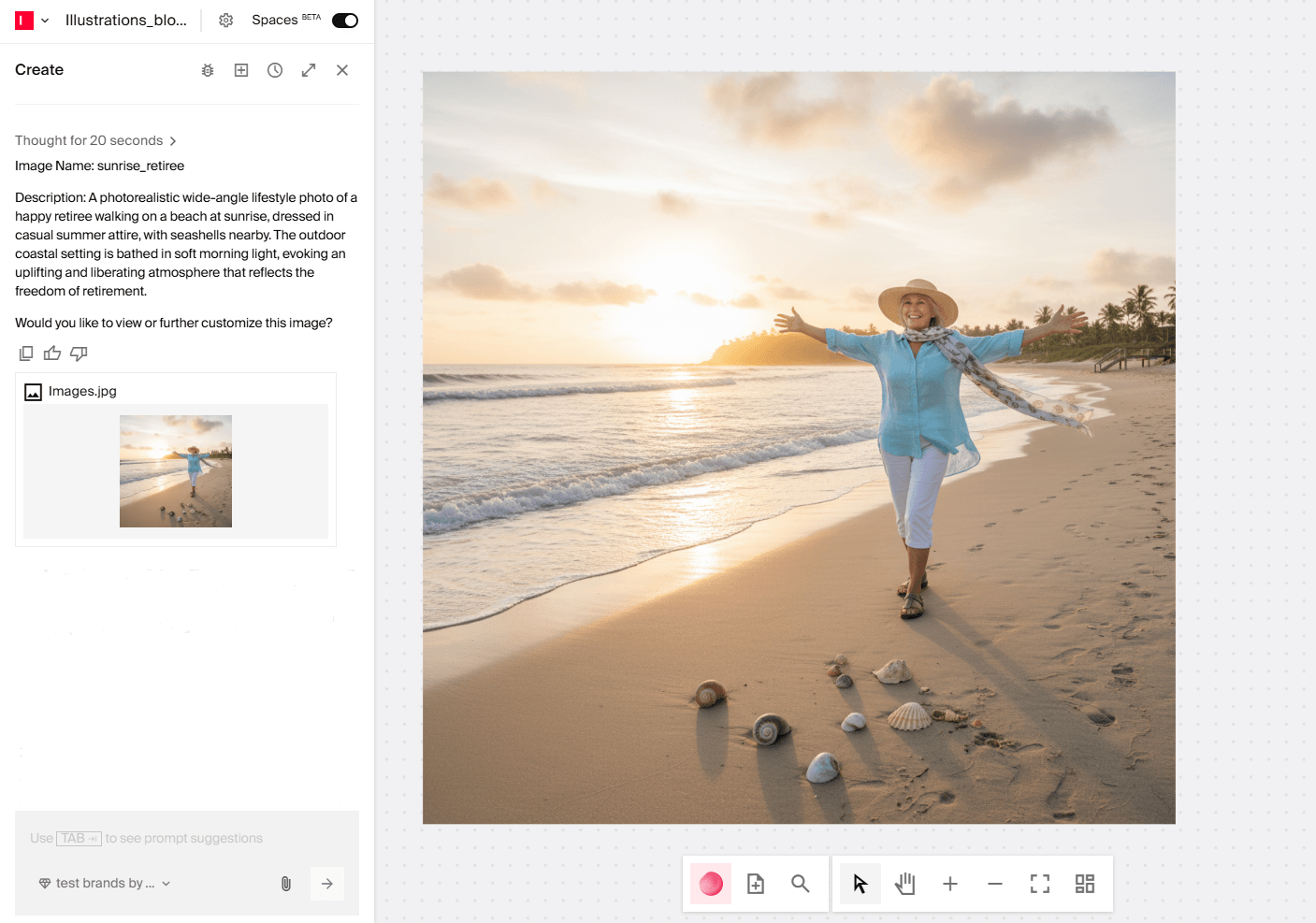
You can easily edit or refine the image:
Request the image in alternative styles (“make this a tropical beach”, “add a Labrador Retriever”) or dimensions (resize to a banner dimension).
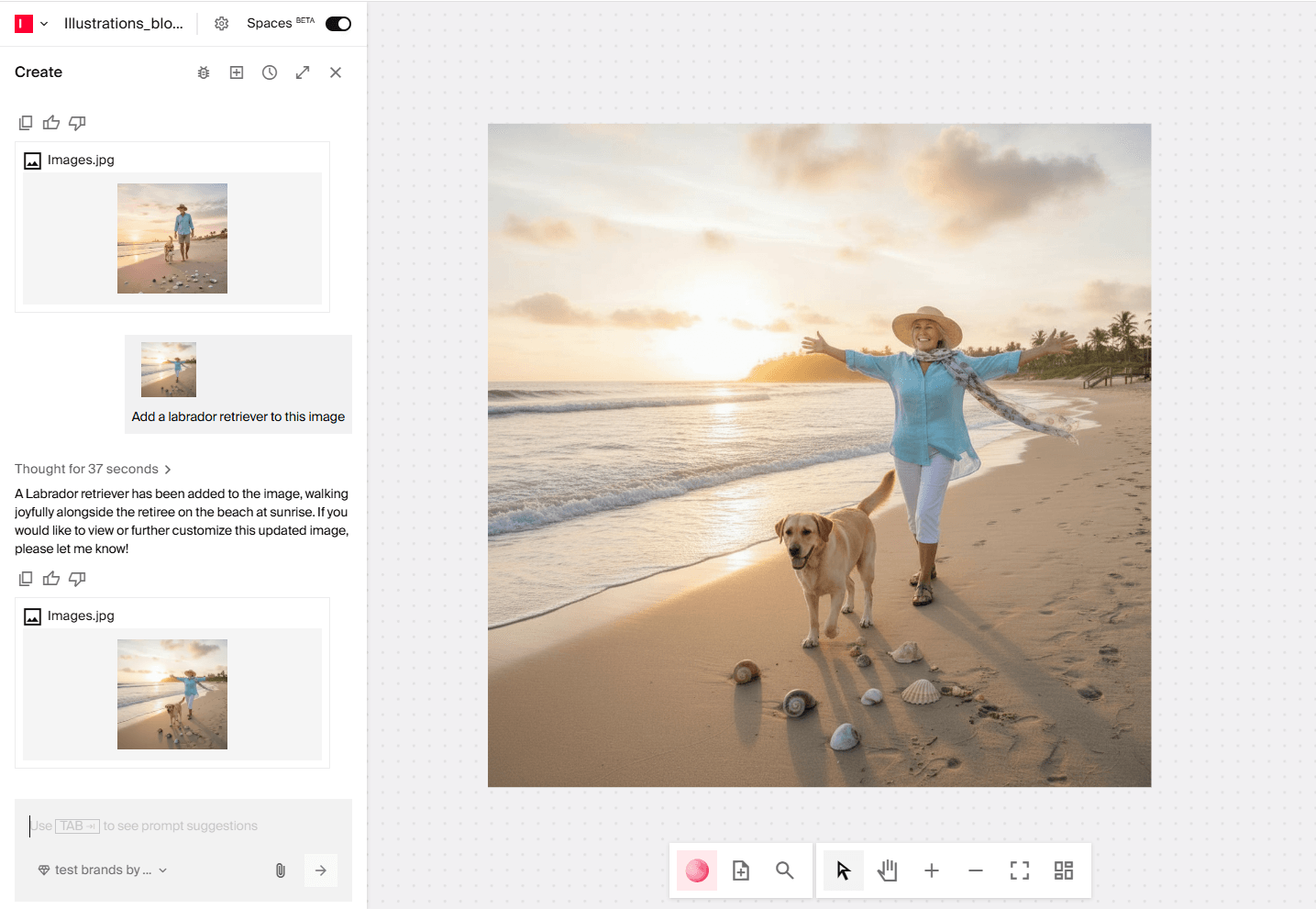
Further, use the built-in Design Editor to fine-tune visuals — add logos, crop, resize, or edit specific areas of the image.
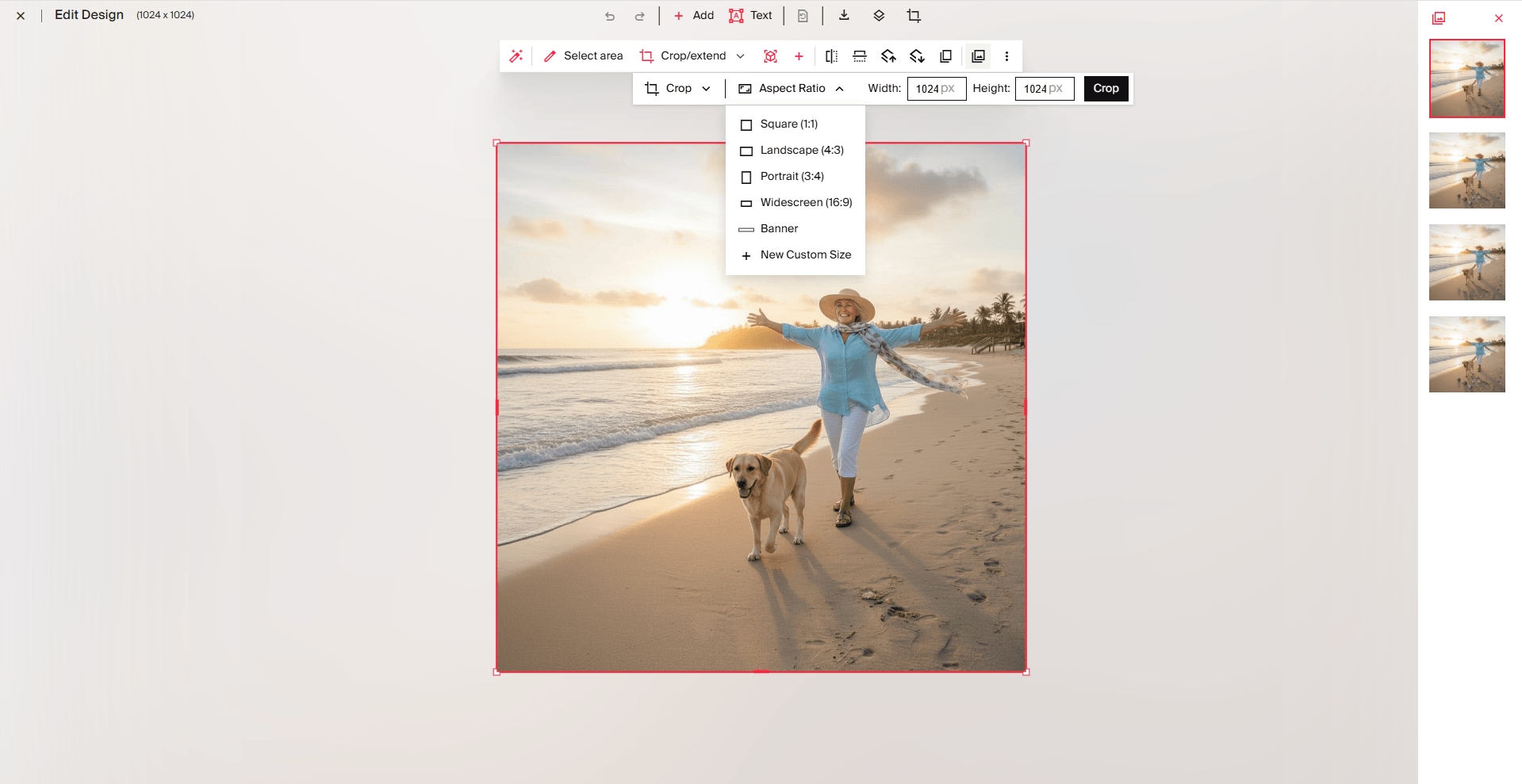
AI image prompts for blogs
Featured image: An [illustration/photo/product shot] for a featured image for a post about [blog topic] in [composition style]. The illustration/photo/product shot should be set in [background scene].
Custom illustration: An illustration for a blog post on [image theme] in [composition style]. The illustration should be set in [background scene].
Header image: An [illustration/photo/product shot] for a blog header with [image subject] in [background scene], [composition style]. The illustration/photo/product shot is for a blog about [blog topic].
Product image: A product photo of [product type] on a [surface type] in a [studio setting], [composition style]. This product photo is for a [product comparison article/product review article/other product marketing blog].
Quote image: An [illustration/photo/product shot] in [composition style], [background scene] for a quote I want to add to my blog post.
Explainer Graphic: An illustration designed to visually explain [topic or concept] for a blog post. The graphic should feature [key elements] in [composition style] and be set against a [background scene] to clearly convey information. The design should be easy to understand and visually engaging, with enough space for brief text descriptions.
💡 Try these AI image prompts on Typeface. Here’s what it looks like:

AI image prompts for social media
Business page profile image: A [photo/illustration] of [image subject] centered against a [background scene]. The photo is in [composition style] and the subject is prominent to ensure visibility in small profile image formats on social media.
Holiday/seasonal-themed image: A festive [photo/illustration] of [product type] set against a [holiday/seasonal background] in [composition style] to capture the holiday spirit.
Product promotion post image: A product photo of [product type] for social, placed against a [background setting] in [composition style]. Leave space on [right/left/top/bottom] for a text overlay.
Contest or giveaway post image: A photo of [product type] against [background setting] in [composition style], with a neatly arranged set of [type of items] in the background for a giveaway bundle.
Video thumbnail image: A [illustration/photo/product shot] of [image subject], against a [background setting] in [composition style] for a video thumbnail. Leave space on [right/left/top/bottom] for a text overlay.
Teaser Image: An [illustration/photo/product shot] featuring a hint of [product type or event subject], partially revealed against a [background setting] in [composition style]. The image should create curiosity, with room on [right/left/top/bottom] for a text overlay to hint at an upcoming reveal.
Call to Action Image: An eye-catching [photo/illustration] of [product type or service feature], placed prominently against a [background setting] in [composition style]. Include ample negative space on [right/left/top/bottom] for a bold CTA text overlay, designed to drive engagement.
💡 Try these AI image prompts on Typeface. Here’s what it looks like:
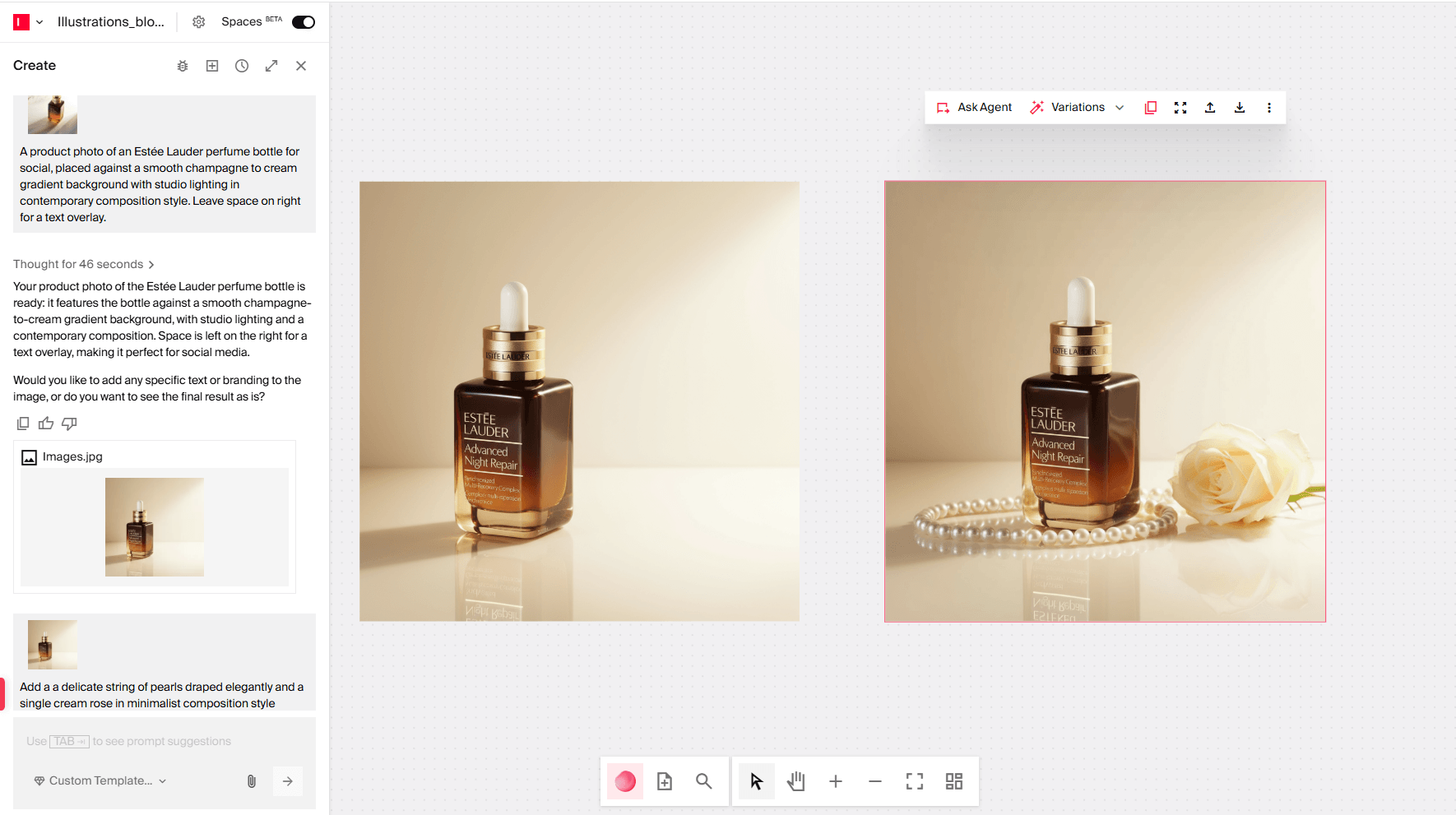
AI image prompts for product marketing
Product flat lay: A product photo of [product type] arranged on a [surface type]. The background has [specific color or texture], and the image is in [composition style], with ample negative space for text overlay.
Product close-up image: A close-up product photo of [product type] on a [surface type], with [background setting], in [composition style] for an eye-catching product detail shot.
Product-in-use image: A product photo showcasing [product type] in use, with [person] demonstrating its functionality or purpose in a [background setting]. The image is shot in [composition style] to capture [specific quality, e.g., ease of use, comfort, performance].
Holiday/seasonal product shot: A product shot of [product type] set against a [seasonal/holiday-themed background]. The product is styled with [types of props].
Influencer-style product feature: A product photo of [product type] in [background setting], shown with [person] interacting with it. The image is in [composition style].
Action shot: An action shot of [product type] in use, highlighting [dynamic aspect, e.g., movement, durability, comfort] in a [background setting], in [composition style].
Lifestyle photo: A product photo featuring [product type] in a [background setting] that reflects [lifestyle theme]. The composition style is [composition style], with [props or people interacting with the product].
💡 Try these AI image prompts on Typeface. Here’s what it looks like:
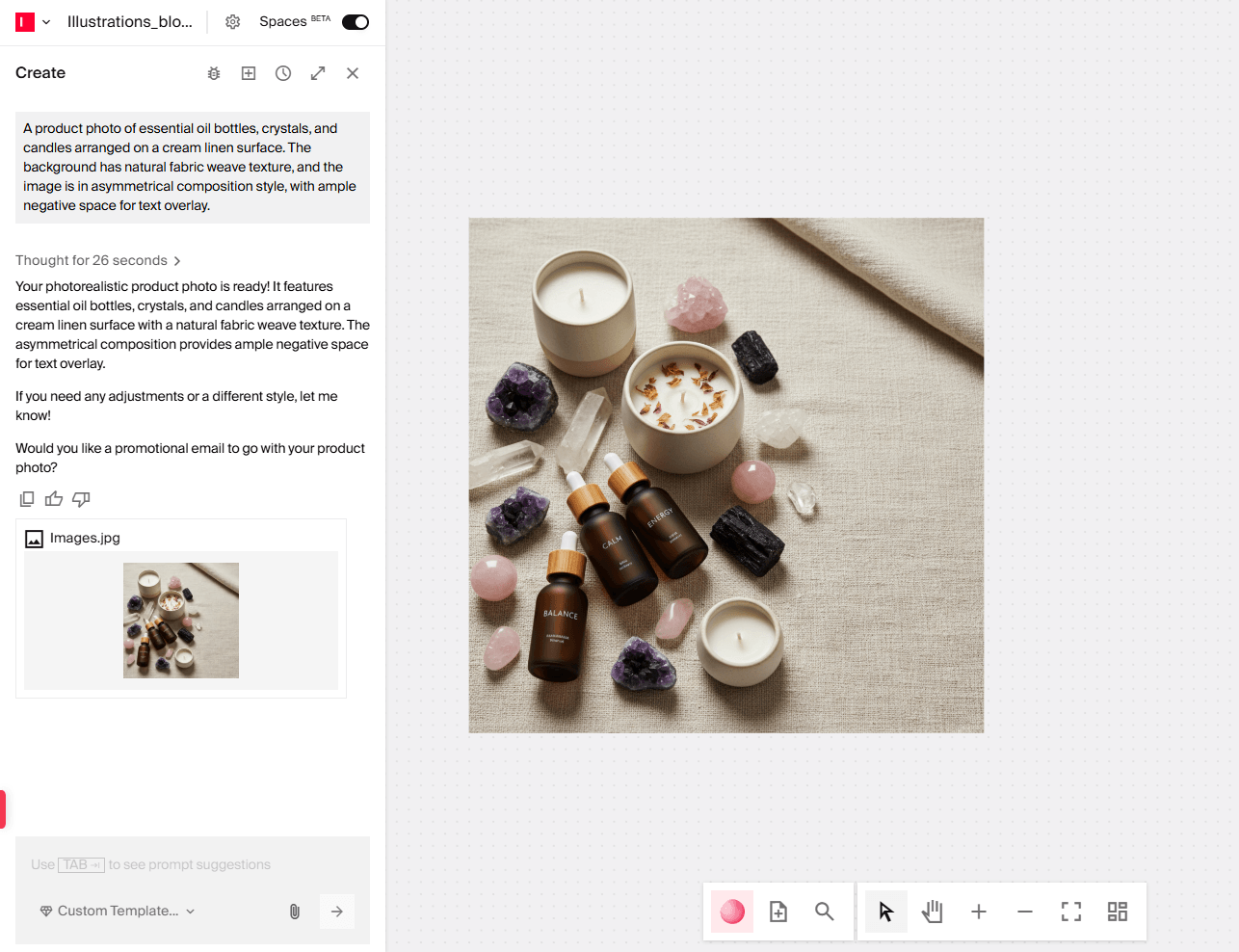
AI image prompts for website graphics
Website hero image: An [illustration/photo/product shot] for a hero image for a website showcasing [image subject] in [background scene], [composition style].
Website logo: An illustration for a logo design for a website, featuring [image subject] in [composition style] with [color palette,] and [symbol or shape, e.g., abstract icon, geometric shape] to represent the brand.
Custom illustrations for webpage: An illustration for a webpage, featuring [theme] in [composition style]. The illustration should be set in [background scene].
Product image for a webpage: A product photo for a webpage, showcasing [product] on a [surface type] with a [background setting] in [composition style]. The photo should be visually appealing for online shoppers.
Landing page CTA banner: An [illustration/photo/product shot] for a landing page banner image with [image subject] against a [background setting] design in [composition style]. The banner should draw attention to the CTA.
CTA Button Design: An illustration/design concept for a CTA button on a website in a [color palette] with [button shape, e.g., rounded, rectangular] and [accent elements, e.g., icon, gradient, shadow].
💡 Try these AI image prompts on Typeface. Here’s what it looks like:
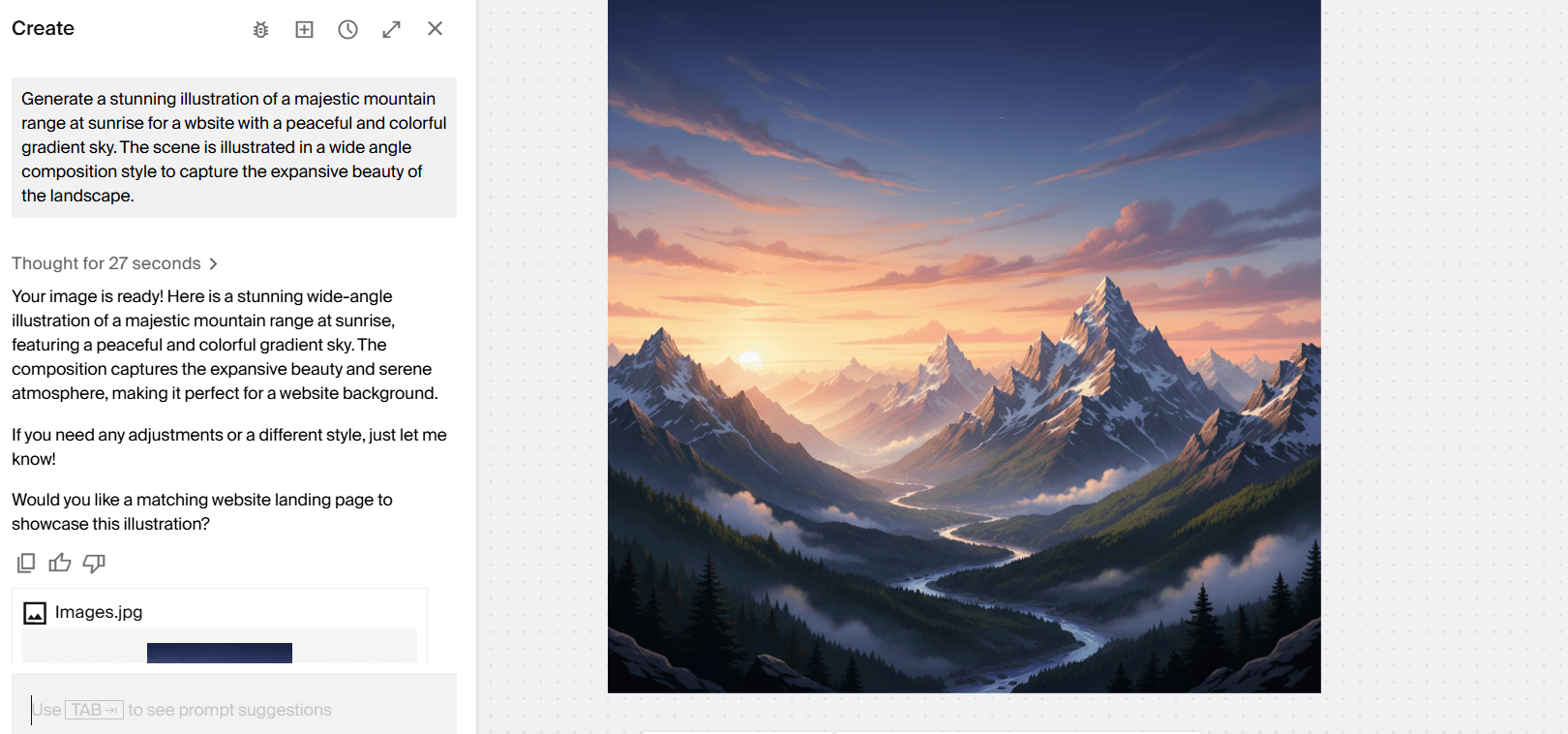
AI image prompts for emails
Feature image: An [illustration/photo/product shot] for a promotional email feature image showcasing [product, service, or theme] in [composition style]. The illustration/photo/product shot should be set in [background scene].
Email header/footer banner: An [illustration/photo/product shot] for an email header/footer banner featuring [image subject] in [background setting] that sets the tone for the email content.
Seasonal/holiday promotion image: An [illustration/photo/product shot] for promotional email, showcasing [image subject] with [holiday/seasonal festive elements] in [composition style] to create a festive, celebratory atmosphere that aligns with the theme.
Product teaser image: A product photo of [product type] with only partial visibility, like [zoomed-in detail or shadowed angle], to spark curiosity for a product teaser email campaign. The image should have [composition style] and be set against a [background setting].
CTA banner image: An [illustration/photo/product shot] of [image subject] against [background setting] in [composition style] for an email CTA banner image. The image should highlight the CTA, making it the focal point of the banner to encourage clicks and engagement.
Custom illustration: An illustration for an email campaign featuring [image subject] against [background setting] in [composition style]. The illustration should be based on [theme].
💡 Try these AI image prompts on Typeface. Here’s what it looks like:
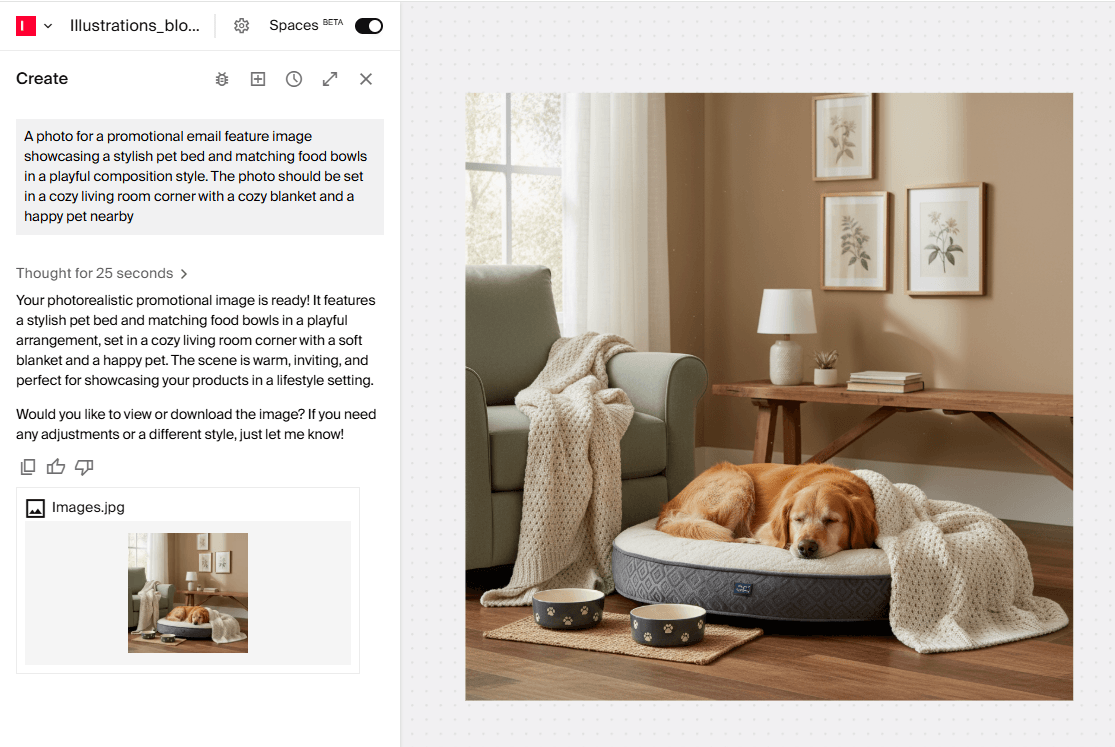
AI image prompts for branding
Logo concept/mark: An illustration for a logo concept featuring [brand element] with [color scheme] in a [composition style] style, designed for [brand type]. The logo is centered on a [background setting], with [composition elements, e.g., bold typography, iconography, abstract shapes].
App icon design: An illustration for an app icon concept for [app type], featuring [key design elements, e.g., a symbol, letter, or abstract shape] in [color scheme] and [composition style]. The icon has [stylistic details, e.g., rounded edges, flat design, 3D elements], placed on a [background scene].
Merchandise mockups: A product photo of a mockup showcasing [merchandise item] placed on a [surface type] with [composition style].
Custom illustrations/graphics: An illustration for [brand use, e.g., website, social media, product packaging], featuring [specific visual elements, e.g., plants, geometric shapes, characters] in a [composition style].
Brand mood board: A brand mood board for [brand name or type] featuring a collage of images including [themes]. The layout has [composition style], using a [color palette] and showcasing elements that convey [tone].
Brand mascot/character design: A brand mascot concept for [brand type] represented as a [type of character] in [color scheme] and [design elements], positioned on a [background setting].
💡 Try these AI image prompts on Typeface. Here’s what it looks like:
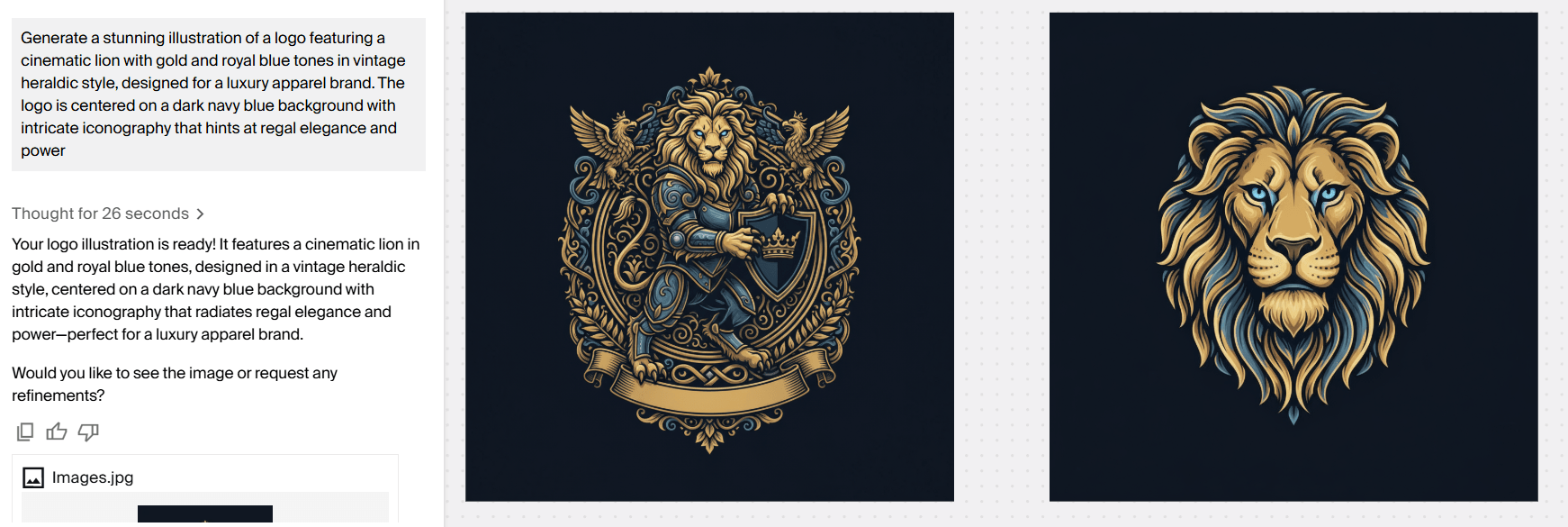
AI image prompts for other marketing creatives
eBook cover: An [illustration/photo/product shot] for an eBook cover for [eBook theme], featuring [image subject] against a [background setting] in [composition style].
eBook images: An [illustration/photo/product shot] for an eBook on [topic], featuring [main elements] on a [background setting] in [composition style].
Diagram: An illustration for a diagram illustrating [topic or concept]. The layout has [diagram structure], set on a [background type].
Case study images: An [illustration/photo/product shot] for a case study on [topic], featuring [image subject] in a [background setting] in [composition style].
Brochure images: An [illustration/photo/product shot] for a brochure on [brochure topic], featuring [image subject] in a [background setting] in [composition style].
Poster: An [illustration/photo/product shot] for a poster for [purpose], featuring [image subject] in a [background setting] in [composition style].
💡 Try these AI image prompts on Typeface. Here’s what it looks like:
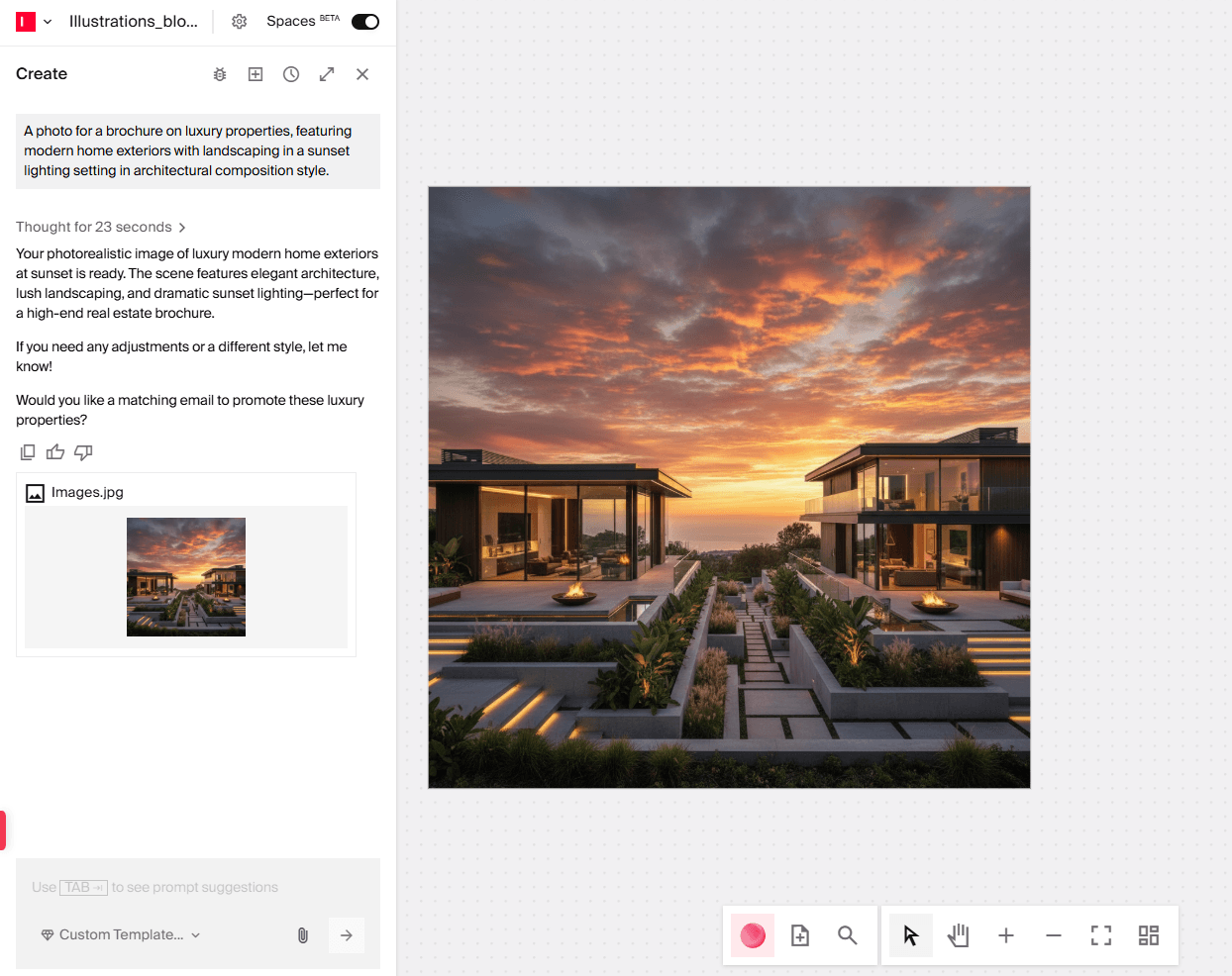
When to use each prompt type
Marketing need | Recommended template | Best for |
|---|---|---|
Blog content | Featured image, header image, custom illustration | Establishing visual hierarchy and supporting written content |
Paid advertising | Product image, product-in-use, CTA button | Driving conversions with a clear product focus |
Social media | Video thumbnail, contest/giveaway, product promotion | Engagement and shareability with text overlay space |
eCommerce | Product flat lay, product close-up, lifestyle photo | Showcasing products in context for purchase decisions, including seasonal/holiday decor |
Email campaigns | Feature image, seasonal promotion, CTA banner | Click-through optimization with brand consistency |
Website design | Hero image, landing page CTA, custom illustrations | First impressions and user journey guidance |
5 AI image prompt mistakes that waste your time
1. Being too vague about composition
If an AI image generator doesn’t get specific details, its outputs will naturally be generic. For example, “nice background" tells the AI nothing. Specify "minimalist white studio" or "busy urban street scene” to get visuals that align with your project and brand.
2. Ignoring spatial guidance
Telling AI where things are and what the environment looks like helps generate images that align with your desired composition, framing, and marketing use case, like social posts or banner ads.
If you need room for text overlay, specify "negative space on the right" or "centered product."
Details like “in a minimalist white studio”, “centered on a plain background”, and “wide angle shot” describe the setting, placement, and spatial relationships, resulting in visuals that look intentional and balanced.
Note: Typeface's Visual Inspiration Studio offers pre-set scenes that you can customize with your brand assets.
3. Requesting text in the image
AI image generators struggle with readable text. Trying to add it directly often produces unreadable or jumbled results. A better strategy is to generate the image first and then add text using editing tools.
4. Overloading with contradictory styles
Mixing styles like "photorealistic cartoon" or “watercolor 3D render” confuses the AI. Stick to a clear style so the image generator knows exactly what to create.
5. Forgetting lighting details
Lighting defines mood, style, and realism. Include lighting details like “golden hour lighting” or “soft diffused lighting" to generate evocative images or to maintain a unified visual theme across your image sets.
The Payoff: Benefits of using AI for marketing creatives
Generative AI tools for designing digital marketing images offer enterprises these main benefits:
1. Faster content production
An AI image creator can significantly reduce the time and effort required to produce high-quality visuals for marketing assets. Marketing teams are seeing tangible results when comparing AI to traditional methods for image generation.
Frank Chen explains:
In scenarios where content velocity is priority and content needs to be produced on a tight budget and timeline, using AI-generated images can help you get to the results you need faster. E2E process from ideation to generated asset is one way to measure efficiency when using AI-generated images vs traditional photography methods.
This efficiency allows marketers to quickly adapt and maintain a consistent flow of fresh content.
2. More time for creative experimentation
By automating the repetitive aspects of graphic design, AI frees up creative professionals to focus on ideation and innovation. One example of this is combining real product photography with AI-generated backgrounds.
As Chen outlines:
In Typeface, you can open any existing image and add a product image by adjusting the product image's orientation and size. Once you go ahead and generate, Typeface will adjust the product's lighting and shadows to make it look properly placed in the scene.
This blend of human creativity and machine precision leads to more unique and compelling marketing photos.
3. Visual consistency
With brand training and battle-tested prompts, AI can create high-quality, consistent visuals at scale. Here’s how this works with Typeface:
Your AI image prompts are saved alongside the content you create, making it easy to revisit past prompts as needed. Your teams can reuse or edit them to generate predictable outputs on-demand, self-sufficiently, and of course, at great efficiency.
You can set up a brand kit in Typeface with visual styles that can guide your image generation to be on brand with a defined style. This reliability minimizes the risk of errors and enables marketers to deliver a uniform visual standard.
Master AI image generation
Using AI image prompts to generate your marketing creatives can transform how your brand communicates with your audience.
With the ability to produce realistic images swiftly and effortlessly, Typeface can be an invaluable asset in any marketer’s toolkit. And by adopting this AI for image generation, marketers can streamline content production and explore new creative possibilities for engagement in the constantly changing marketing world.
FAQs
1. What are AI image generators?
AI image generators are tools that use artificial intelligence to generate images from text prompts or content templates. They can create anything from photorealistic product shots to abstract art based on your input. Their core strength is interpreting your descriptions to create detailed, accurate images in seconds.
2. How do you generate good AI images?
Generating high-quality AI images starts with a good prompt structure:
[Image type] of [main subject] in [background scene], [composition style].
If you're using Typeface to generate images and brand photos, you can use Magic Prompt to automatically enhance basic descriptions with technical specifications and descriptive modifiers.
3. How do you improve an image with AI prompts?
Improving AI-generated images with AI image prompts is an iterative process that requires systematic testing.
Start by analyzing what's working and what isn't in your current results. If the composition is good but the lighting feels off, add specific lighting descriptors like "golden hour lighting," "soft diffused light," or "dramatic side lighting."
Be more specific about style elements. Instead of just saying "professional," try "editorial photography with shallow depth of field." Add technical photography terms like "shot with 85mm lens" or "f/2.8 aperture" to achieve more professional results.
Use negative prompts to exclude unwanted elements. If your images consistently include distracting background elements, explicitly mention what you don't want.
Experiment with different aspect ratios and compositions by specifying "wide-angle view," "close-up macro shot," or "bird's eye view perspective."
Change one part of the AI image prompt at a time so you can identify which modifications produce better results. Many teams iterate through 5-10 AI prompt variations before finding their perfect formula.
To make editing easier, you can use Typeface's advanced features for AI image editing. It offers image editing tools for inpainting, outpainting (using generative AI to extend an image), resizing, and also for adjusting lighting, shadows, and adding/removing specific elements in the AI image.
4. How long should an AI image prompt be?
There’s no fixed length for an AI image prompt. What matters most is clarity — describe key details in simple, concise terms so AI understands your intent and creates an accurate image, nothing more, nothing less.
5. Can you use AI image prompts on any platform?
Not exactly. While most AI image generators use text prompts as their main input, each platform has its own rules and formatting requirements. Some may include parameters, keywords, or even allow image URLs.
Different tools also run on different AI models, which interpret language in unique ways. So, a prompt that works perfectly on one tool might not deliver the same results on another platform.
6. What's the difference between AI image prompts and regular image briefs?
AI prompts are concise instructions to guide AI that has no prior knowledge of your brand or project beyond what you've provided. Therefore, they rely heavily on descriptive terms, style references, and technical parameters. In addition, these inputs are carefully arranged to help the AI interpret your needs correctly.
Regular image briefs are written for humans. They’re broader, don't need strict formatting, and are open to creative interpretation — ideal for human creatives who can read between the lines, grasp subtext, and ask clarifying questions.
7. Do AI image prompts work the same on all generators?
Each AI image generator has its own architecture, training data, understanding of language, and distinct strengths. The descriptive words you use for one may be interpreted differently in another, so you’ll need to adjust your prompts to get similar results on different AI image tools.
8. How many times should I iterate on a prompt before starting over?
Rather than focusing on the number of iterations, focus on making thoughtful refinements each time. Sometimes, even a small tweak can significantly improve your results.
When you do need to adjust your AI image prompts, make targeted changes rather than starting from scratch. Change one element at a time, adjust the lighting, modify the background, or tweak the composition. This approach helps you understand what works and builds your prompting skills more effectively.
Restart with a new prompt when the fundamental concept is off, but if you want to preserve the overall aesthetic you've achieved while making specific improvements, use AI image editing instead.
As Chen suggests:
If you like most things about an image, but just wanted to change one small part (e.g. remove one object, add something to a specific part of the image), then you can edit the image using Typeface's AI editing tools. If you want to create an entirely new image, you can generate it using a different prompt.
9. What are some ways to improve your prompts for AI art?
Here are some ways to improve your prompts for AI images or AI art:
Start by front-loading your most important elements as AI prioritizes the beginning of prompts. Lead with your image type and main subject, then build out supporting details.
It's also a good idea to learn photography and art terminology, as these terms help AI understand professional visual concepts and produce better results.
Build AI image prompt for different campaign types. Develop standardized structures for product shots, lifestyle images, or social media content that you can customize for specific needs. This ensures a balance of speed and visual consistency across your marketing materials.
Study successful examples and reverse-engineer their prompts. When you see an AI-generated image that works well, analyze its components and adapt the approach for your brand. You can build a library of effective descriptors and style combinations that align with your visual identity.
In Typeface, Magic Prompt enhances your prompts after considering your entire marketing context, not just individual words. It understands campaign types, product categories, and audience segments to build out prompts with relevant marketing and technical descriptors.
10. Which AI creates the most realistic images?
The "most realistic" depends on your goal. For product photography, you might prioritize accurate color reproduction and clean backgrounds. For lifestyle images, focus on natural expressions and authentic settings. For brand illustrations, consistency in style may matter more than realism.
The best AI image generator is one that produces consistent results aligned with your brand standards while fitting seamlessly into your content creation process. Typeface combines powerful AI generation with marketing-focused features and collaborative workflows that help teams create on-brand visuals efficiently.
Fortune 500 companies choose Typeface for its blend of multiple best-in-class AI models and enterprise-grade customization. Brands report that Typeface-generated product images rival professional photography, while being produced 10x faster and at a fraction of the cost.
Related: Typeface customer stories
11. What are the limitations of using AI to generate images from prompts?
Current AI models can struggle with complex text within images, specific brand logo recreation, and highly detailed technical diagrams that require precision. AI also has difficulty with very specific product details or technical accuracy.
If your marketing requires exact product specifications, or if you want to add text overlays, logos, and other branded assets, it's best to use an AI image editing tool like Typeface.
Maintaining consistency across image sets can be tricky. Great individual images don’t always align in lighting, perspective, or character appearance. Typeface's Brand Kit addresses this issue by applying brand-trained styles across generated images.
Despite these limitations, AI image generation continues advancing rapidly, and platforms like Typeface are specifically designed to address many of these marketing-focused challenges.
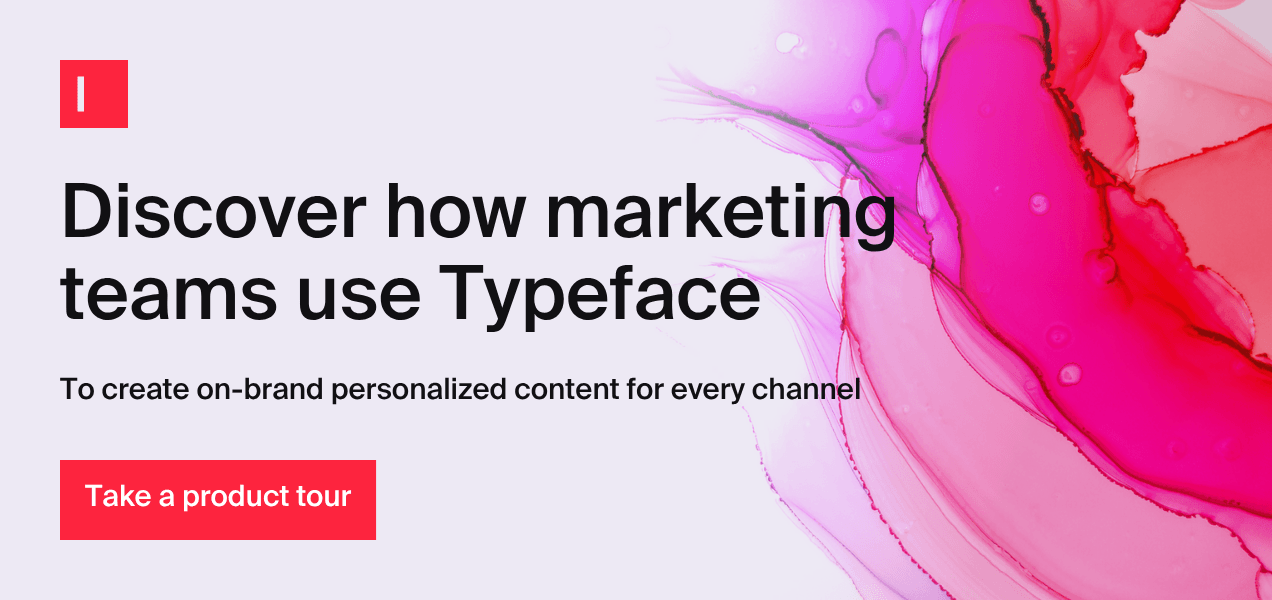
Share
Related articles
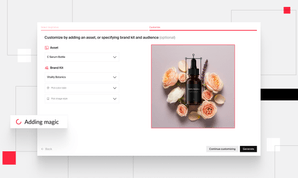
Product
Beyond Prompts: A New Way to Ideate and Create Using Images in Visual Inspiration Studio

Frank Chen · Product Manager
October 9th, 2024 · 6 min read
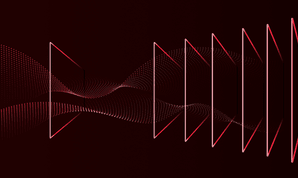
AI at Work
Orchestrating AI: the Transition From Solo Acts to a Complete Symphony

Abhay Parasnis · Founder and CEO
August 28th, 2024 · 6 min read
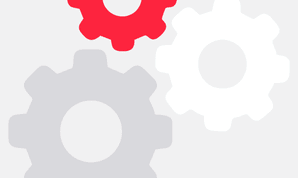
AI at Work
How to Use AI Image Generation Tools to Create Holiday Banners for Landing Pages and Ads

Neelam Goswami · Content Marketing Associate
November 27th, 2024 · 16 min read